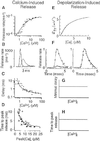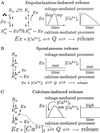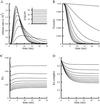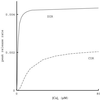Can the Ca2+ hypothesis and the Ca2+-voltage hypothesis for neurotransmitter release be reconciled?
- PMID: 12486235
- PMCID: PMC139284
- DOI: 10.1073/pnas.242549999
Can the Ca2+ hypothesis and the Ca2+-voltage hypothesis for neurotransmitter release be reconciled?
Abstract
It is well established that Ca2+ plays a key role in promoting the physiological depolarization-induced release (DIR) of neurotransmitters from nerve terminals (Ca2+ hypothesis). Yet, evidence has accumulated for the Ca2+-voltage hypothesis, which states that not only is Ca2+ required, but membrane potential as such also plays a pivotal role in promoting DIR. An essential aspect of the Ca2+-voltage hypothesis is that it is depolarization that is responsible for the initiation of release. This assertion seems to be contradicted by recent experiments wherein release was triggered by high concentrations of intracellular Ca2+ in the absence of depolarization [calcium-induced release (CIR)]. Here we show that there is no contradiction between CIR and the Ca2+-voltage hypothesis. Rather, CIR can be looked at as a manifestation of spontaneous release under conditions of high intracellular Ca2+ concentration. Spontaneous release in turn is governed by a subset of the molecular scheme for DIR, under conditions of no depolarization. Prevailing estimates for the intracellular calcium concentration, [Ca2+]i, in physiological DIR rely on experiments under conditions of CIR. Our theory suggests that these estimates are too high, because depolarization is absent in these experiments and [Ca2+]i is held at high levels for an extended period.
Figures







Similar articles
-
Autoreceptors, membrane potential and the regulation of transmitter release.Trends Neurosci. 2000 Feb;23(2):60-8. doi: 10.1016/s0166-2236(99)01498-8. Trends Neurosci. 2000. PMID: 10652546 Review.
-
Release of neurotransmitter induced by Ca2+-uncaging: reexamination of the ca-voltage hypothesis for release.J Comput Neurosci. 2005 Aug;19(1):5-20. doi: 10.1007/s10827-005-0187-4. J Comput Neurosci. 2005. PMID: 16133822
-
The 'Ca-voltage' hypothesis for neurotransmitter release.Biophys Chem. 1988 Feb;29(1-2):85-93. doi: 10.1016/0301-4622(88)87027-3. Biophys Chem. 1988. PMID: 2896021 Review.
-
Membrane depolarization evokes neurotransmitter release in the absence of calcium entry.Nature. 1989 Nov 23;342(6248):433-5. doi: 10.1038/342433a0. Nature. 1989. PMID: 2573839
-
Contribution of Ca2+ inflow to quantal, phasic transmitter release from nerve terminals of frog muscle.Pflugers Arch. 1992 Nov;422(2):129-42. doi: 10.1007/BF00370412. Pflugers Arch. 1992. PMID: 1362607
Cited by
-
A novel fast mechanism for GPCR-mediated signal transduction--control of neurotransmitter release.J Cell Biol. 2011 Jan 10;192(1):137-51. doi: 10.1083/jcb.201007053. Epub 2011 Jan 3. J Cell Biol. 2011. PMID: 21200029 Free PMC article.
-
Action potential modulates Ca2+-dependent and Ca2+-independent secretion in a sensory neuron.Biophys J. 2009 Mar 18;96(6):2449-56. doi: 10.1016/j.bpj.2008.11.037. Biophys J. 2009. PMID: 19289069 Free PMC article.
-
A simulation study on the Ca2+-independent but voltage-dependent exocytosis and endocytosis in dorsal root ganglion neurons.Eur Biophys J. 2005 Nov;34(8):1007-16. doi: 10.1007/s00249-005-0486-8. Epub 2005 Jun 10. Eur Biophys J. 2005. PMID: 15947975
-
Control of neurotransmitter release: From Ca2+ to voltage dependent G-protein coupled receptors.Pflugers Arch. 2010 Nov;460(6):975-90. doi: 10.1007/s00424-010-0872-7. Epub 2010 Sep 2. Pflugers Arch. 2010. PMID: 20811904 Review.
-
The timing of phasic transmitter release is Ca2+-dependent and lacks a direct influence of presynaptic membrane potential.Proc Natl Acad Sci U S A. 2003 Dec 9;100(25):15200-5. doi: 10.1073/pnas.2433276100. Epub 2003 Nov 20. Proc Natl Acad Sci U S A. 2003. PMID: 14630950 Free PMC article.
References
Publication types
MeSH terms
Substances
LinkOut - more resources
Full Text Sources
Miscellaneous

